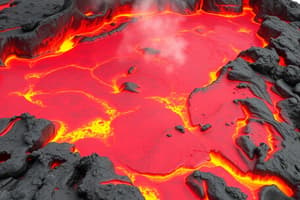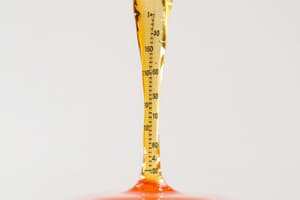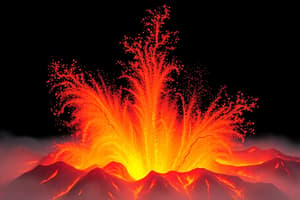Podcast
Questions and Answers
Which term best describes the property of a material that characterizes its resistance to flow?
Which term best describes the property of a material that characterizes its resistance to flow?
- Density
- Porosity
- Elasticity
- Viscosity (correct)
What does a higher viscosity indicate about a liquid?
What does a higher viscosity indicate about a liquid?
- It is more gas-like in behavior.
- It is thicker and more resistant to flow. (correct)
- It has a lower temperature.
- It is thinner and flows easily.
Which of the following statements is NOT true regarding viscosity?
Which of the following statements is NOT true regarding viscosity?
- Viscosity can affect the behavior of fluids under different conditions.
- Viscosity is related to how thick or sticky a liquid is.
- A more viscous liquid resists flow more than a less viscous one.
- All liquids have the same viscosity regardless of their state. (correct)
In the context of viscosity, which of the following would have the least resistance to flow?
In the context of viscosity, which of the following would have the least resistance to flow?
If a liquid is described as having low viscosity, what can be inferred about it?
If a liquid is described as having low viscosity, what can be inferred about it?
What is one primary factor that affects the eruptive style of a volcano?
What is one primary factor that affects the eruptive style of a volcano?
What is the primary cause of volcanic eruptions?
What is the primary cause of volcanic eruptions?
Which of the following scenarios is likely to cause magma to rise?
Which of the following scenarios is likely to cause magma to rise?
Which of these factors is least likely to impact the eruptive style of a volcano?
Which of these factors is least likely to impact the eruptive style of a volcano?
What role does water play in volcanic activity?
What role does water play in volcanic activity?
How does the chemical composition of magma influence volcanic eruptions?
How does the chemical composition of magma influence volcanic eruptions?
At which location would you most likely find an increase in temperature contributing to volcanic activity?
At which location would you most likely find an increase in temperature contributing to volcanic activity?
Why is the amount of dissolved gases in magma important for volcanic eruptions?
Why is the amount of dissolved gases in magma important for volcanic eruptions?
Which factor is NOT associated with the formation of magma?
Which factor is NOT associated with the formation of magma?
Which combination of factors would likely lead to the most explosive volcanic eruption?
Which combination of factors would likely lead to the most explosive volcanic eruption?
What is a hot spot in geology?
What is a hot spot in geology?
Why does magma escape at hot spots?
Why does magma escape at hot spots?
What happens to magma as it rises to a hot spot?
What happens to magma as it rises to a hot spot?
Which of the following statements about hot spots is accurate?
Which of the following statements about hot spots is accurate?
What is the primary source of magma at a hot spot?
What is the primary source of magma at a hot spot?
What effect does subduction have on the melting temperature in the asthenosphere?
What effect does subduction have on the melting temperature in the asthenosphere?
Which tectonic plate is being subducted in the Cascadia Subduction Zone?
Which tectonic plate is being subducted in the Cascadia Subduction Zone?
What type of volcano forms when two oceanic plates converge?
What type of volcano forms when two oceanic plates converge?
How does the convergence of oceanic and continental plates affect volcano formation?
How does the convergence of oceanic and continental plates affect volcano formation?
Which of the following is NOT represented in the diagram of the Cascadia Subduction Zone?
Which of the following is NOT represented in the diagram of the Cascadia Subduction Zone?
What is the relationship between silica content and viscosity in magma?
What is the relationship between silica content and viscosity in magma?
Which type of magma is likely to travel further before solidifying?
Which type of magma is likely to travel further before solidifying?
In terms of viscosity, how do low silica magmas compare to high silica magmas?
In terms of viscosity, how do low silica magmas compare to high silica magmas?
What is the effect of increasing silica content in magma on its fluidity?
What is the effect of increasing silica content in magma on its fluidity?
Which statement accurately describes the movement of low silica magmas?
Which statement accurately describes the movement of low silica magmas?
How does the presence of gas in magma affect its flow?
How does the presence of gas in magma affect its flow?
What happens to magma viscosity in near-surface environments due to gas loss?
What happens to magma viscosity in near-surface environments due to gas loss?
Which of the following statements about gas in magma is true?
Which of the following statements about gas in magma is true?
In the context of magma, what role do gases like water vapor play?
In the context of magma, what role do gases like water vapor play?
What structural formations can result from magma that has undergone gas loss?
What structural formations can result from magma that has undergone gas loss?
How does an increase in the temperature of magma affect its viscosity?
How does an increase in the temperature of magma affect its viscosity?
What happens to the viscosity of lava as it flows and cools?
What happens to the viscosity of lava as it flows and cools?
If magma is initially at a high temperature, what can be expected about its ability to flow?
If magma is initially at a high temperature, what can be expected about its ability to flow?
When does magma reach a point where it stops flowing?
When does magma reach a point where it stops flowing?
What effect does high viscosity have on the movement of lava?
What effect does high viscosity have on the movement of lava?
Which part of a volcano serves as the pathway for lava to reach the surface?
Which part of a volcano serves as the pathway for lava to reach the surface?
What is the term used for the solid material ejected during a volcanic eruption?
What is the term used for the solid material ejected during a volcanic eruption?
Which part of the volcano contains the molten rock before it erupts?
Which part of the volcano contains the molten rock before it erupts?
What volcanic feature is primarily responsible for the cone shape of a volcano?
What volcanic feature is primarily responsible for the cone shape of a volcano?
Which layer of a volcano is characterized by loose rock and volcanic debris?
Which layer of a volcano is characterized by loose rock and volcanic debris?
Which flow type can travel a great distance due to its very fluid-like characteristics?
Which flow type can travel a great distance due to its very fluid-like characteristics?
Which type of magma flow is described as breaking up as it flows due to its viscosity?
Which type of magma flow is described as breaking up as it flows due to its viscosity?
What is the primary characteristic of the Rhyolitic Dome?
What is the primary characteristic of the Rhyolitic Dome?
How does Rhyolitic Spire behave compared to other types of magma?
How does Rhyolitic Spire behave compared to other types of magma?
Which type of magma flow is likely to have the least movement due to its viscosity?
Which type of magma flow is likely to have the least movement due to its viscosity?
Flashcards
Viscosity
Viscosity
A material's resistance to flow.
What is viscosity?
What is viscosity?
Viscosity is a measure of a fluid's thickness and stickiness.
Viscosity and resistance
Viscosity and resistance
The higher the viscosity, the greater the resistance to flow.
Viscous material behavior
Viscous material behavior
Signup and view all the flashcards
Less viscous material behavior
Less viscous material behavior
Signup and view all the flashcards
Magma's Temperature
Magma's Temperature
Signup and view all the flashcards
Magma's Chemical Composition
Magma's Chemical Composition
Signup and view all the flashcards
Dissolved Gases
Dissolved Gases
Signup and view all the flashcards
Amount of Dissolved Gases
Amount of Dissolved Gases
Signup and view all the flashcards
Volcanic Eruption Style
Volcanic Eruption Style
Signup and view all the flashcards
What is magma?
What is magma?
Signup and view all the flashcards
How do volcanoes form?
How do volcanoes form?
Signup and view all the flashcards
How does pressure affect magma formation?
How does pressure affect magma formation?
Signup and view all the flashcards
What is a hot spot?
What is a hot spot?
Signup and view all the flashcards
How does subduction affect magma formation?
How does subduction affect magma formation?
Signup and view all the flashcards
What are Hot Spots?
What are Hot Spots?
Signup and view all the flashcards
How do hot spots create volcanoes?
How do hot spots create volcanoes?
Signup and view all the flashcards
How does magma form in hot spots?
How does magma form in hot spots?
Signup and view all the flashcards
What are hot spot volcanoes?
What are hot spot volcanoes?
Signup and view all the flashcards
What is a chain of volcanoes?
What is a chain of volcanoes?
Signup and view all the flashcards
What makes magma viscous?
What makes magma viscous?
Signup and view all the flashcards
How does silica content affect magma's flow?
How does silica content affect magma's flow?
Signup and view all the flashcards
How does magma viscosity affect eruption style?
How does magma viscosity affect eruption style?
Signup and view all the flashcards
How does magma viscosity affect eruption style?
How does magma viscosity affect eruption style?
Signup and view all the flashcards
Why is magma viscosity important?
Why is magma viscosity important?
Signup and view all the flashcards
What is subduction?
What is subduction?
Signup and view all the flashcards
Volcanoes and Subduction
Volcanoes and Subduction
Signup and view all the flashcards
How does magma form in subduction zones?
How does magma form in subduction zones?
Signup and view all the flashcards
Volcanic Formation at Continental-Oceanic Boundaries
Volcanic Formation at Continental-Oceanic Boundaries
Signup and view all the flashcards
Volcanic Formation at Oceanic-Oceanic Boundaries
Volcanic Formation at Oceanic-Oceanic Boundaries
Signup and view all the flashcards
Gases and Magma Viscosity
Gases and Magma Viscosity
Signup and view all the flashcards
Gas Loss and Viscosity Increase
Gas Loss and Viscosity Increase
Signup and view all the flashcards
Dome or Columnar Formation
Dome or Columnar Formation
Signup and view all the flashcards
Gas Content and Explosive Eruptions
Gas Content and Explosive Eruptions
Signup and view all the flashcards
Gas Content and Eruption Style
Gas Content and Eruption Style
Signup and view all the flashcards
Basaltic Flow
Basaltic Flow
Signup and view all the flashcards
Andesitic Flow
Andesitic Flow
Signup and view all the flashcards
Rhyolitic Dome/Spire
Rhyolitic Dome/Spire
Signup and view all the flashcards
Magma Viscosity and Eruption Style
Magma Viscosity and Eruption Style
Signup and view all the flashcards
How does magma's temperature affect its viscosity?
How does magma's temperature affect its viscosity?
Signup and view all the flashcards
What happens to lava's flow as it cools?
What happens to lava's flow as it cools?
Signup and view all the flashcards
What is magma viscosity?
What is magma viscosity?
Signup and view all the flashcards
How does magma viscosity relate to its temperature?
How does magma viscosity relate to its temperature?
Signup and view all the flashcards
How do gases in magma affect eruptions?
How do gases in magma affect eruptions?
Signup and view all the flashcards
What is the Main Vent/Crater?
What is the Main Vent/Crater?
Signup and view all the flashcards
What is a Secondary Vent?
What is a Secondary Vent?
Signup and view all the flashcards
What is the Magma Chamber?
What is the Magma Chamber?
Signup and view all the flashcards
What is Lava?
What is Lava?
Signup and view all the flashcards
What is the Cone?
What is the Cone?
Signup and view all the flashcards
Study Notes
Viscosity
- Viscosity is a material's resistance to flow.
- It's described as the liquid's thickness and stickiness.
- The more viscous and thicker the material, the greater its resistance to flow.
Studying That Suits You
Use AI to generate personalized quizzes and flashcards to suit your learning preferences.
Description
Test your knowledge on the concepts of viscosity and the dynamics of volcanic eruptions. This quiz covers the properties of materials related to flow resistance and important factors influencing volcanic activity. Answer questions about magma, gas content, and eruption styles to demonstrate your understanding of these key scientific concepts.




